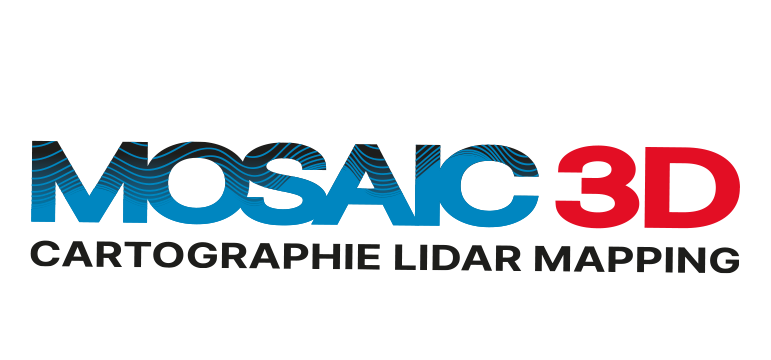
LIDAR APPLICATIONS
Topography under forest cover
LiDAR can gather ground elevation data in a dense forest, whereas photogrammetry fails to reveal the precise surface of the terrain due to the density of the forest cover. The LiDAR laser passes through this vegetated cover where the light passes, which provides a sufficient data sample to produce a quality Digital Terrain Model (DTM).
In the image, the red points represent vegetation while the blue ones are the points measured on the ground.
VUE EN PLAN
VUE EN PROFIL
Similarly, the image on the left below shows a forest covering a hillside. On the right, the same place without trees reveals the paths and shows enough points to create a good topography model.
Damp area detection
The return of the LiDAR signal occurs at different intensities, depending on the object hit by the laser. Infrared light from LiDAR is strongly absorbed by water and is therefore an excellent way to show wet and damp areas, therefore well-drained soils. Damp areas are not always clearly visible on an aerial photo, compared to an intensity image. The damp areas are visible in black.
Restricted space between buildings
In the case of buildings very close to each other, obtaining 3D information on the ground could be ineffective by interpreting aerial images. LiDAR, by sending more than half a million points per second, will obtain measured data by passing over these tight spaces. It is easy to improve LiDAR point density by changing the flight path, while aerial photography follows predetermined lines.

Simplicity in collecting, consulting and transferring data
With LiDAR technology, data can be gathered quickly with extreme precision. Data acquisition can even be done in the evening or at night, without problems of shading or lightning, since the sensor emits its own light. Viewing 3D point cloud data is done with simple software and everything can be easily integrated into any type of mapping program. Additionally, handling and transferring 3D point files is easier than with photography files which are much heavier.
LIDAR PRODUCTS
Here are examples and descriptions of different products that can be generated following a LiDAR survey.
Point cloud
A point cloud shows millions of places hit by the laser. Since all these points have a precisely measured position, the result gives a three-dimensional view of the scanned area.
Contour lines


Digital Terrain Model (DTM)
A map showing the ground elevation with all
vegetation and infrastructure removed – different colors represent different elevations.


Digital Surface Model (DSM)
Digital model in which vegetation and infrastructure are not removed.

Slope model
A map showing different degrees of slope on the ground surface.

LiDAR intensity images
The laser we use sends out an infrared wavelength and the amount of light returning from the surface can be displayed. This image makes it possible to determine the precise position of infrastructure (roads, buildings, forests, rivers, etc.) LiDAR intensity images are sometimes even used to help validating the position of aerial photographs.
Digitizing on intensity image
It is possible to scan the elements in 2D and 3D on an intensity image. The accuracy of the infrastructure position will be determined by the density of LiDAR points per square meter.
The following examples are intensity images on which roads and buildings have been scanned.


















